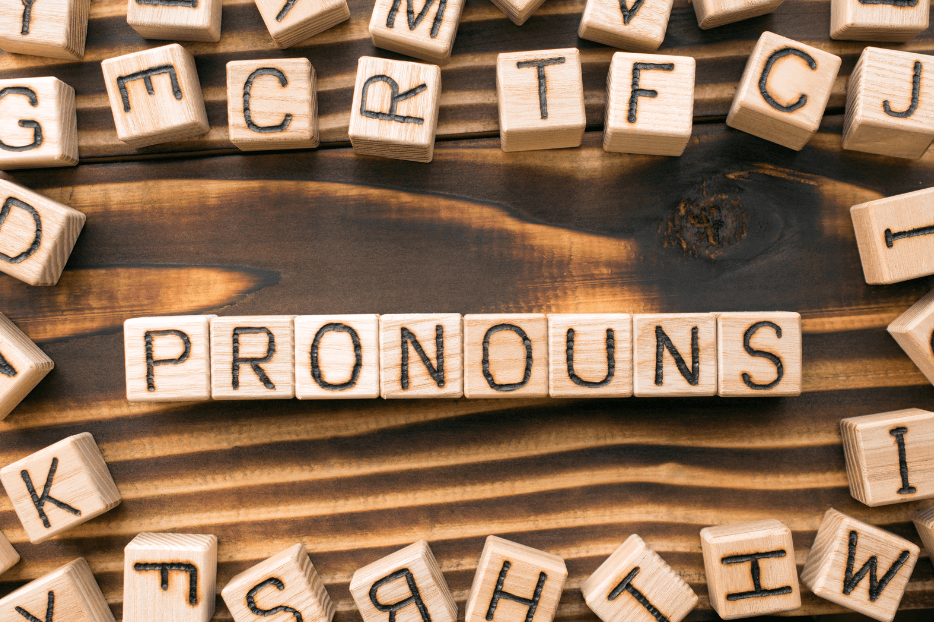Exploring the 7 Types of Pronouns: A Fun Grammar Lesson

Ever noticed how often we use words like he, they, or this in conversations? These words may seem small, but they play a big role in making our language smooth and clear. They’re called pronouns, and there are seven different types you should know!
Whether your child is writing stories or giving a speech, understanding these pronouns helps them express ideas with precision and confidence. At PlanetSpark, we turn tricky grammar concepts into fun, interactive lessons that kids love.
Let’s dive into the 7 types of pronouns through simple explanations and easy examples!
Understanding the 7 Types of Pronouns
Pronouns help us avoid repeating names and nouns in sentences. From simple words like he and they to more specific ones like who or which, each type has a unique role. Let’s explore the 7 different types of pronouns and how they work.
1. Personal Pronouns
Personal pronouns are the most commonly used pronouns in both speech and writing. They replace specific people or things and help avoid repeating the same nouns. These pronouns vary based on their role in the sentence, whether as the subject or the object.
Examples:
Subject pronouns: I, you, he, she, it, we, they
Object pronouns: me, you, him, her, it, us, them
In a sentence:
She is reading a book. (subject)
Can you help me with this puzzle? (object)
Quick Tip: Using personal pronouns makes sentences smoother and more natural. They help your writing feel less repetitive and more engaging.
2. Reflexive Pronouns
Reflexive pronouns refer back to the subject of the sentence. They are used when the subject and the object of the sentence are the same person or thing.
Examples:
Myself, yourself, himself, herself, itself, ourselves, yourselves, themselves
In a sentence:
I taught myself how to play the guitar.
She looked at herself in the mirror.
Quick Tip: Reflexive pronouns help you show that someone is doing something on their own, without needing to repeat the subject.

Join interactive sessions where children learn English grammar through games, stories, and real-life usage.
Book a Free Demo Now!
3. Demonstrative Pronouns
Demonstrative pronouns are used to point to specific people or things. They help us show whether something is nearby or far away, and whether it’s singular or plural.
Examples:
This, that, these, those
In a sentence:
This is my favourite book.
Those were the best days of our vacation.
Helpful Hint: Use “this” and “these” for things that are close. Use “that” and “those” when talking about things that are farther away.
4. Interrogative Pronouns
Interrogative pronouns are used to ask questions. They help us gather information about people or things and usually appear at the beginning of a question.
Examples:
Who, whom, whose, which, what
In a sentence:
Who is your best friend?
What are you looking for?
Which color do you prefer?
Quick Tip: “Who” refers to people, “what” refers to things or ideas, and “which” is used when there's a choice between limited options.
5. Reflexive Pronouns
Reflexive pronouns are used when the subject and the object of a sentence are the same person or thing. They reflect the action back to the subject and usually end in -self (singular) or -selves (plural).
Examples:
Myself, yourself, himself, herself, itself, ourselves, yourselves, themselves
In a sentence:
I made this cake myself.
She looked at herself in the mirror.
We treated ourselves to some ice cream.
Quick Tip: Avoid using reflexive pronouns in place of regular pronouns, saying “Please contact myself” is incorrect. Say “Please contact me” instead.
6. Reciprocal Pronouns
Reciprocal pronouns show a mutual relationship or action between two or more people. They are used when each person in a group does something to the others.
There are only two reciprocal pronouns:
Each other
One another
In a sentence:
The two friends hugged each other before saying goodbye.
The team members encouraged one another throughout the match.
Quick Tip: Use each other for two people and one another for more than two, though this rule is often relaxed in everyday speech.
7. Relative Pronouns
Relative pronouns connect a clause or phrase to a noun or pronoun. They help add more information about the noun without starting a new sentence.
Common relative pronouns include:
who
whom
whose
which
that
In a sentence:
The boy who won the race is my brother.
The book that you gave me is fascinating.
She’s the artist whose paintings were exhibited.
Quick Tip: Relative pronouns act like bridges, linking ideas smoothly and clearly in complex sentences.

Make Grammar Easy and Engaging for Your Child!
Book a free demo class and help your child master grammar topics like pronouns, verbs, and tenses the fun way
Summary of 7 Types of Pronouns
| Type of Pronoun | Function | Examples |
|---|---|---|
| Personal Pronouns | Refer to people or things directly | I, you, he, she, it, we, they |
| Possessive Pronouns | Show ownership or possession | mine, yours, his, hers, ours, theirs |
| Reflexive Pronouns | Reflect the action back to the subject | myself, yourself, himself |
| Demonstrative Pronouns | Point to specific things or people | this, that, these, those |
| Interrogative Pronouns | Ask questions | who, what, which, whom, whose |
| Indefinite Pronouns | Refer to non-specific people or things | anyone, everyone, something, few |
| Relative Pronouns | Link clauses to a noun and add information | who, whom, whose, which, that |
Pronoun Usage Tips
Learning how to use pronouns correctly is essential for building strong English skills. These simple tips will help students understand and use pronouns for Class 6 more effectively:
1. Match the Pronoun with the Noun
Always match the pronoun with the noun it replaces in number (singular or plural) and gender.
Example:
❌ Sara lost their book.
✅ Sara lost her book.
2. Replace Repeating Nouns
Pronouns help avoid repeating the same noun too often. This is one of the most useful rules taught in lessons on pronouns for Class 6.
Example:
Repetitive: Riya loves Riya’s dog because Riya thinks Riya’s dog is cute.
Better: Riya loves her dog because she thinks it is cute.
3. Use Reflexive Pronouns Correctly
Reflexive pronouns (like myself, yourself, himself) are used when the subject and object are the same.
Example:
✅ He hurt himself while playing.
❌ He hurt him while playing.
4. Be Clear with Indefinite Pronouns
Avoid using multiple indefinite pronouns (someone, everyone, etc.) in the same sentence without clarity.
Example:
Confusing: Everyone did something at some time.
Clear: Each student completed their part of the group project.
5. Make the Meaning Clear
The pronoun should clearly refer to the right noun to avoid confusion.
Example:
Confusing: When Priya met Anu, she was excited.
Clear: Priya was excited when she met Anu.
6. Always Capitalise “I”
The pronoun “I” should always be written with a capital letter, no matter where it appears.
Example: My friends and I are going to the park.
7. Practice Often
To master pronouns for Class 6, regular practice is key. Encourage children to write simple sentences, diary entries, or stories using different types of pronouns

How PlanetSpark Makes English Grammar Fun and Effective for Kids
At PlanetSpark, English Grammar isn’t about memorising rules. It’s about learning by doing, through conversations, stories, and games that make grammar stick.
Here’s what sets PlanetSpark’s Grammar program apart:
Interactive, Not Rote: Kids learn grammar through stories, dialogues, and real-world usage instead of dry rule lists.
From Concept to Creation: Every concept moves from understanding ➝ application ➝ sentence formation ➝ live writing correction.
Gamified Practice: With quizzes, puzzles, Kahoots, and games, grammar learning becomes engaging and memorable.
Built-In Writing Practice: After each lesson, kids apply what they’ve learned through sentence-building and writing tasks.
Progressive Learning Paths: From basics like nouns and verbs to advanced topics like passive voice and reported speech, learning scales with the child.
Real-Time Reports for Parents: Track your child’s grammar growth in sentence fluency, structure, and grammatical accuracy.
Let your child master English Grammar the fun and meaningful way with lessons that move from knowledge to confident writing.
Conclusion
Strong grammar skills are the foundation of confident communication. When kids understand how sentences work, they write and speak with clarity, purpose, and power. But grammar doesn’t have to be boring or rule-heavy. With the right approach, it can be fun, engaging, and deeply rewarding.
That’s exactly what PlanetSpark offers, an English Grammar program designed to turn grammar concepts into lifelong skills. Whether your child is just beginning with nouns and punctuation or ready to explore complex structures, PlanetSpark provides a step-by-step path to mastery.
Readers Also Read
English Grammar: Adverbs for Class 4
Explore adverbs of manner, place, time, frequency, and more, complete with easy examples and clear explanations for Class 4 learners. PlanetSparkSingular and Plural Nouns for Kids
Learn the rules for forming and using singular and plural nouns, from regular endings to tricky irregular forms—perfect for building strong grammar basics.
FAQs on English Grammar
1. What is the best way for kids to learn English grammar?
The best way is through usage-based learning where kids practice grammar through reading, writing, and speaking instead of just memorizing rules.
2. At what age should children start learning English grammar?
Kids can start learning grammar concepts as early as age 5 with simple parts of speech like nouns and verbs. Learning should match their comprehension level and grow with them.
3. Why is English grammar important for students?
English grammar helps students write clearly, speak fluently, and understand what they read. It builds a strong foundation for academic success and real-world communication.
4. How can I help my child improve their grammar at home?
Read stories together, play word games, and encourage writing activities. Enroll them in a structured grammar program that focuses on application, not just theory.
5. What are the core topics in English grammar for kids?
Key grammar topics include nouns, pronouns, verbs, adjectives, tenses, punctuation, sentence structure, active/passive voice, and reported speech.
6. How does PlanetSpark teach English grammar differently?
PlanetSpark uses interactive methods like role-play, story-based learning, gamified quizzes, and writing practice to make grammar fun and easy to retain.
Download Free Worksheets
Personalized Communication Report
Record a video to get a AI generated personalized communication report for your child

Hi There, want to try these
tips for your child with
LIVE with our expert coach?
Let's check your child's
English fluency

